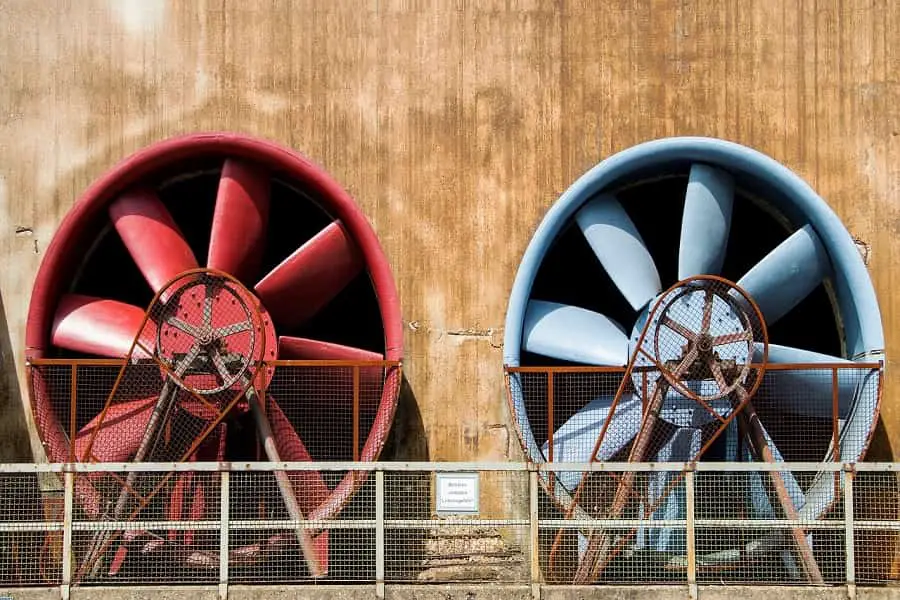Air movers are typically used to remove moisture from material surfaces into the air. The two most common types of air movers are centrifugal and axial. You can also use these air movers in different applications, such as cooling and fume removal from enclosed areas. Suppose you plan to purchase an air mover. In that case, you need to see what you are trying to accomplish first, meaning maybe you need to circulate some air or dry an area that just got wet due to a water leak.
So, keep in mind that each air mover is made specifically for each application. Getting the right air mover is critical. (Below) let’s go through the difference between a centrifugal and axial air mover, which applications these air movers are used, and why they are different.
Difference Between Centrifugal and Axial Air Movers
The difference between the centrifugal air mover and the axial fan is that the air fills the inlet area through centrifugal force in the centrifugal housing. In contrast, the axial fan is a linear motion, which means the air passes directly through the fan, meaning from the back to the front at a low force.
Now that we know the difference between a centrifugal blower and axial fans, let’s dive into a quick explanation of where these air movers are used.
Centrifugal Air Mover
Centrifugal air movers, also called air blowers or carpet dryers, are most commonly used to dry carpets and floors. They have a multi-speed motor creating an extremely high flow of air when needed. For example, carpet cleaners like to use these centrifugal air movers to dry the carpet more quickly after being cleaned.
Low Profile Centrifugal Air Mover
Now, with today’s technology, low-profile centrifugal air movers are also being built, as you can see in the image above, making them easier to store, carry, and move around efficiently.
Axial Air Mover
Axial air movers, also called a fan, work best for drying ceilings, walls, and structures with less force than a centrifugal air mover. Axial air movers are also available in a low and high capacity; however, they run at low amp compared to carpet dryers (blowers).
Related: Can you run an air conditioner without a filter
Low and High Pressure Air Mover Applications
Air movers are available with low and high pressure. (Below) let’s go through a quick explanation of what makes air movers low and high pressure.
Centrifugal Low-Pressure Air Mover
Low-pressure centrifugal air movers are used to dry organic wood floors, kitchen, and bathroom cabinets and blow air into cavities. Most centrifugal low-pressure air movers use 4-5 amps of electricity, good enough to make the carpet float in the air when placed underneath the carpet.
Centrifugal High-Pressure Air Mover
Centrifugal high-pressure air movers are ideal for powering vent and or manifold systems as well. Most centrifugal high-pressure air movers use 10-12 amps of electricity. They use much more power than standard carpet dryers. It is important to note that a high-pressure air mover comes with a higher horsepower motor making them ideal for drying large applications.
Axial Low-Pressure Air Mover
An axial low-pressure air mover specializes in moving large volumes of air with a low amp draw and is primarily used during in-place drying. An axial low-pressure air mover uses very low amps, 1.5 to 3.0 amps, and produces significantly more airflow volume than carpet dryers. However, axial air movers produce little or no pressure, so you cannot use them to duct air.
Axial High-Pressure Air Mover
High-pressure axial air movers can also be used with various ventilation systems to dry cavities. However, they are most often used to produce significant positive or negative pressures. Axial high-pressure air movers, as I mentioned earlier, they are commonly referred to as fans. An axial high-pressure air mover uses 2.5 to 8.8 amps, and they are used to move mass volumes of air through ductwork.
How to Clean an Air Mover
Keeping these air movers clean and in good working conditions is essential for better efficiency and performance. After researching, I found this helpful video that shows how to properly clean your air mover to avoid dust and bacteria build-up.
Related
- Read the full article about what tool measures indoors humidity and a few helpful tips on how to control high levels of humidity.




